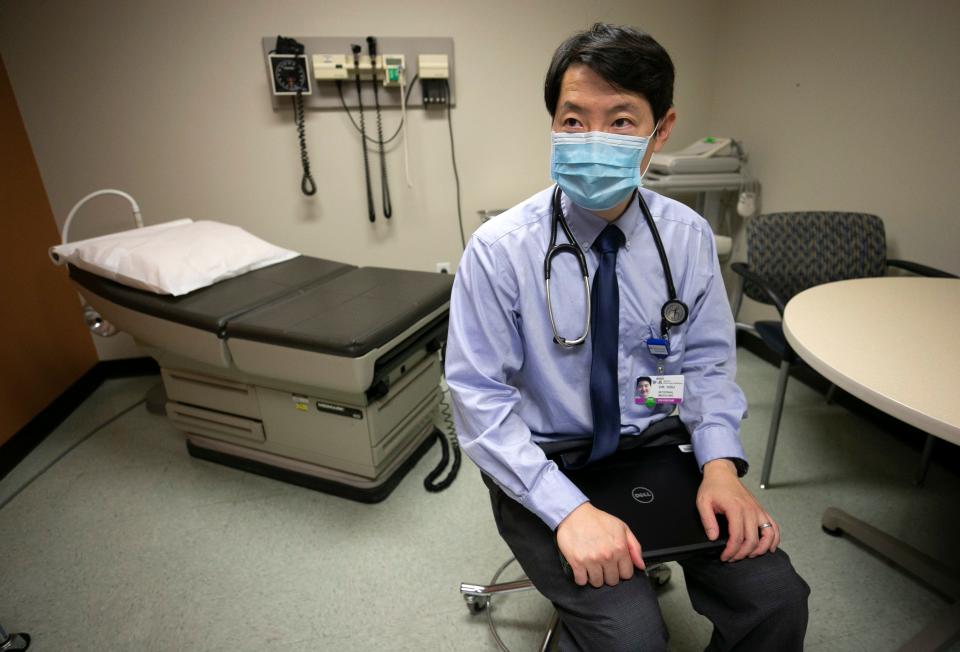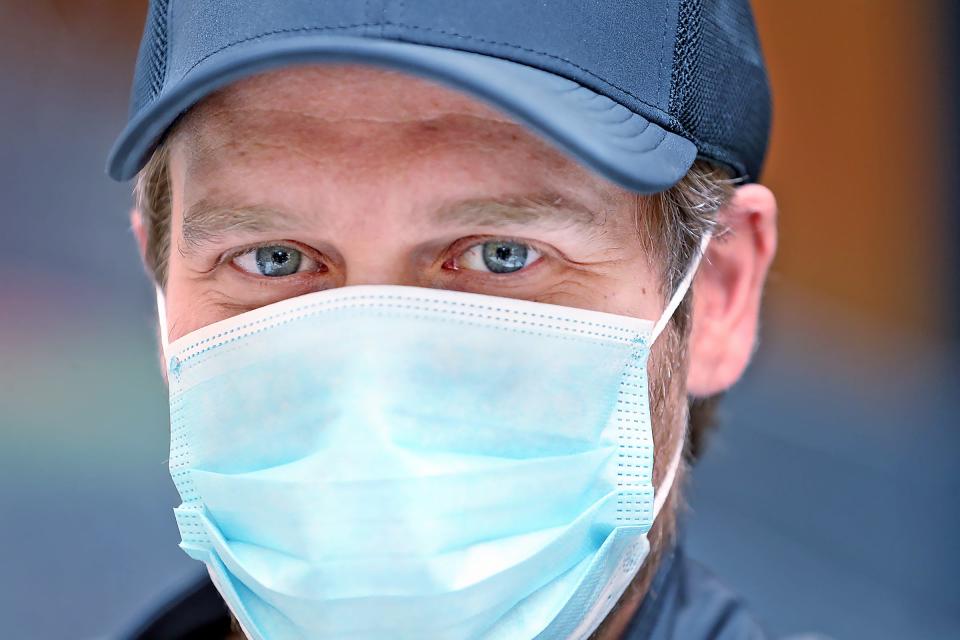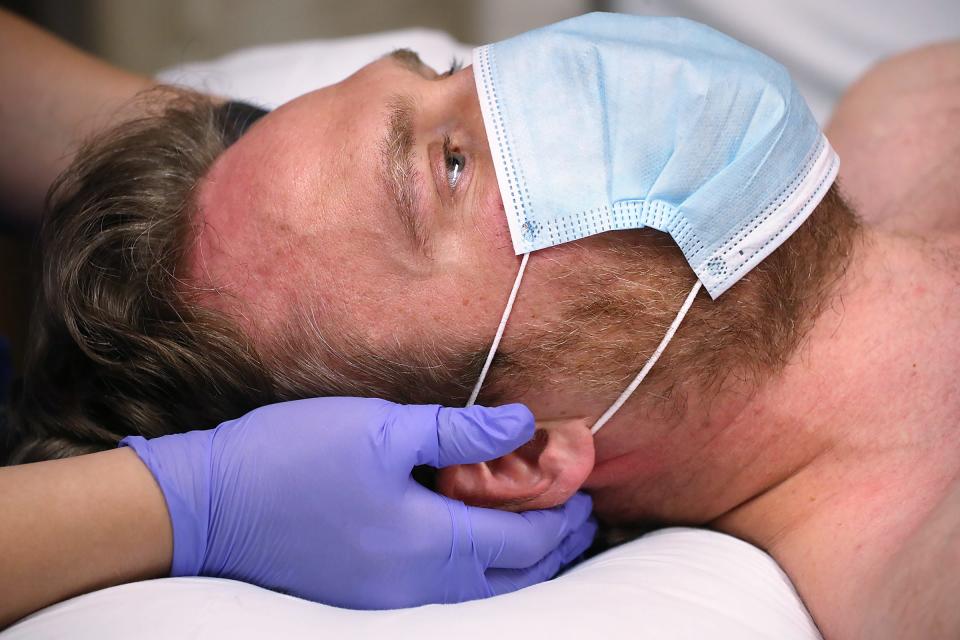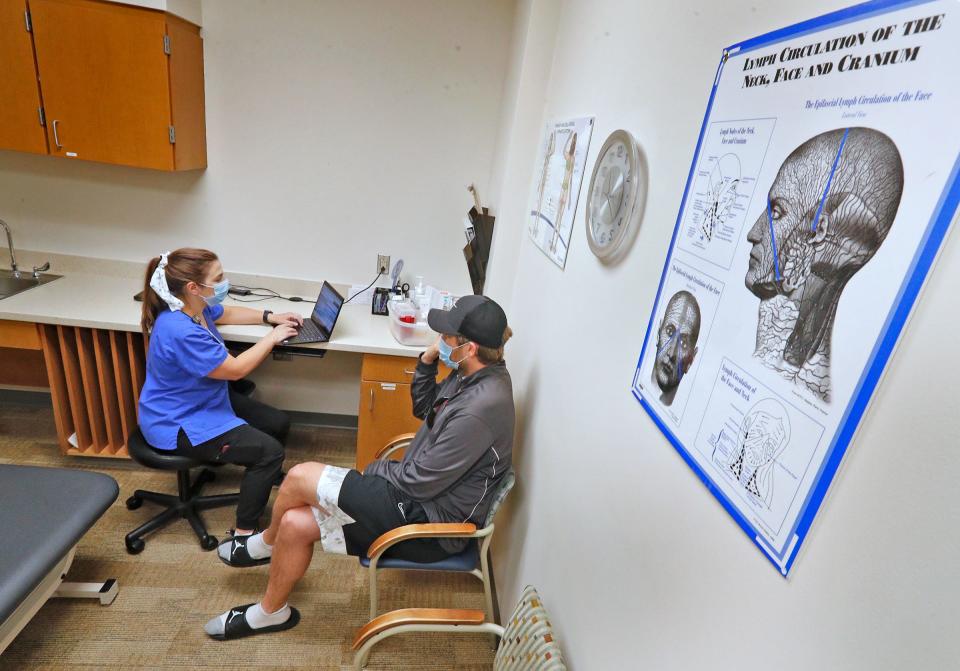What is the proper treatment for long COVID? New clinics seek answers
While the list of symptoms associated with long-haul COVID-19 may be long, the list of medications to treat it is short. But doctors – and their patients – don’t have the luxury of waiting for the science to catch up with the virus.
As more people survive COVID-19 infections yet continue to suffer, health care has begun to respond with multidisciplinary clinics that connect patients with a range of experts. They work together to devise a plan, operating without a playbook because treatment guidelines have yet to be written.
Demand already exceeds supply at many clinics, an ongoing challenge, said Dr. Peter Staats, who serves on the medical advisory board for Survivor Corps, a grassroots group of COVID-19 survivors.
CHANGED BY COVID
Day three of a weeklong USA TODAY Network series exploring long-haul COVID-19, the people who’ve suffered and the experts trying to help them. If you don’t want to miss future stories in this series, sign up for our COVID-19 newsletter here.
“This is a huge and tremendous problem,” said Staats, a pain specialist and president of the Institute of World Pain. “This is going to be a wave of health care problems that we have not seen the likes of before.”
Doctors are encountering patients like Lisa O’Brien, a 43-year-old auditor and single mother of two who lives just north of Salt Lake City. She fell ill and got better – until she didn’t.
O’Brien’s heart raced, she was out of breath and felt zinging vibrations in her body, as though her nerve endings were being repeatedly shocked. She frequently would lie down on the floor just to feel less bad.
But when she tried to get help, she found herself trying to prove she was sick. Doctors brushed off her concerns. A few offered her anxiety medication. Nothing helped.
“My body was so dysfunctional, and not behaving the way it should, and nobody had any answers,” O’Brien said. “It was a nightmare.”
Then, in June 2020, O’Brien found the Mount Sinai Center for Post COVID Care in New York City, one of the first clinics in the country for patients with post-infection COVID-19 illness.
Energized by the reception she received there, O’Brien became an advocate for specialty clinics. Some of her efforts paid off when the University of Utah COVID-19 Long-Hauler Clinic saw its first patient in July.
Just like COVID-19, these new clinics are far from uniform. Some focus on one or a handful of symptoms, such as smell and taste, headaches or heart problems. Others seek to address a range of complaints.
Some formed specifically to treat long-haul COVID-19; others pivoted to the new disease. Doctors find themselves engaging in trial and error to figure out what works.
Many have long waiting lists.
As usual, the people most disadvantaged by long-term COVID-19, experts say, are those who are generally the most disadvantaged: rural residents, people of color, those without financial resources, those uncomfortable with or not trusting of medical care.
Dr. Zijian Chen, an endocrinologist at the Icahn School of Medicine at Mount Sinai, said he’s concerned that clinics will treat those who show up at their doors rather than all those who need help.
“We don’t want to preferentially treat those who seek help; we want to reach out to those who may not even know the help is out there,” he said.
Rural America: Long COVID-19 amplifies chronic health care challenges
One basic challenge lies in treating a condition that includes so many symptoms. A patient-led study of 3,762 participants in 56 countries, published July 15 in The Lancet, identified more than 200 symptoms of long-haul COVID-19, across 10 organ systems.
That’s where multidisciplinary clinics can play an important role, connecting patients to a range of experts.
“We need long-COVID clinics at a minimum to kind of be the centralized location where the referrals are happening … and doctors are talking to each other,” said Hannah Davis, a long-haul COVID-19 patient and volunteer leader in New York City with The Patient-Led Research Collaborative.
“My experience has basically been juggling my own health care across 13 different specialists,” said Davis, 33. “It’s completely not sustainable.”
Individual patients report 21 symptoms on average, ranging from fatigue to debilitating headaches, from all-over body pain to trouble breathing, from gastrointestinal problems to heart concerns, said Natalie Lambert, an Indiana University biostatistician studying the many ways COVID-19 can affect health.
“We still don’t have a perfect definition of long COVID,” said Lambert, who also is Survivor Corps’ director of research. “We need to be creating effective standards of care that we can use now even before we have effective treatment plans. It’s really about not waiting until we have perfect answers.”
Patients search for someone who believes them
Patients may not be seeking the perfect answer as much as a sympathetic ear. In some instances, they’re playing instrumental roles in creating clinics after getting the runaround from individual providers.
The Mayo Clinic in Rochester, Minn., opened a clinic in spring 2020, after COVID-19 patients discharged from the hospital reached out for help, said Dr. Greg Vanichkachorn, an occupational medicine doctor there.
Since then, the clinic has seen hundreds of patients from across the country, more than half via telemedicine.
“The one universal trait among them is they all feel very abandoned,” Vanichkachorn said. “When patients come to Mayo, one of the most important treatments is simply listen to them.”
O’Brien did not get tested for the coronavirus until more than two weeks after her first symptoms – and the test was negative. The Mt. Sinai providers listened anyway and, she said, confirmed her suspicions that she had long-haul COVID-19.
“Just had my apt with Mt. Sinai today,” she wrote in a June 9, 2020 post on the Facebook page Long Haul COVID Fighters, a national support group. “They want to help us and figure out why this is happening. I have never felt so understood in my life! They know we Long Haulers exist!”
After Mt. Sinai clinicians recommended treatments and medications she could find in Utah, O’Brien created another Facebook group for Utah Long Haulers – and later one for Long Haulers in Arizona, too. She spent months lobbying providers, researchers, medical centers and health systems to establish a comprehensive clinic in Utah.
“I was like, ‘I’ve got to create this group, find everybody that I can and show that there’s going to be demand and we’re going to need help,’ ” O’Brien said. “Plus I didn’t want anybody to go through it alone. It’s so huge to know that you are not the only one who feels like you are going crazy.”
The newly opened University of Utah COVID-19 Long Hauler Clinic is designed as a resource for patients, offering intake, screening and referrals. While clinics for ALS, muscular dystrophy and some other diseases bring multiple specialists under one roof, that seemed too tricky for COVID-19, said clinic medical director Dr. Jeanette Brown.
“It wouldn’t be very efficient for our subspecialists,” she said. “We primarily serve to get patients into the system and get them seeing the right providers.”
On average, patients get three referrals to subspecialists, she said, most commonly cardiologists, neurologists and pulmonologists. The initial screening aims to weed out those with symptoms unrelated to COVID-19, such as one post-COVID-19 patient whose fatigue turned out to stem from a gastrointestinal bleed.
Andrew Stott, 31, a software development engineer and single father, spent three months on the University of Utah’s Long Haul waiting list.
The Provo resident had tested positive for the coronavirus just before Thanksgiving and was sick for about 10 days. He struggled to breathe, his heart raced and he had body aches, including joint pain that he feared was arthritis.
When Stott went back to work, even simple physical movements felt like wading through water. His regular doctor dismissed his anxiety, he said, and ordered thousands of dollars of tests that yielded no answers.
At the University of Utah, Stott said providers gave him a treatment plan and followed up with a phone call.
“That was the biggest thing in the world. … Having a doctor that validated me and actually followed up with me after an appointment – wow,” he said. “The biggest source of comfort for me outside of the Facebook group is actually having a group of physicians who aren’t seeing a bunch of broken ankles and runny noses. ... They are living and breathing this COVID stuff.”
Some health systems start new programs, others evolve
Health care systems are turning to a variety of models to determine the best way to treat the flood of patients, while anticipating more to come from the latest COVID-19 surge.
Some are deploying new approaches to care, while in others clinics already formed to treat other conditions are pivoting to handle long-haul COVID-19.
Banner Health, Arizona’s largest health care delivery system, is building a network of 100 or more providers who will treat long-haul COVID-19 patients, said Dr. Bethany Bruzzi, chief medical officer of clinical efficiency in Tucson. The model calls for clinics staffed with specialists in three major service areas: Phoenix, Tucson and northern Colorado.
“Rather than the patient having to get a runaround of specialists and whatnot, we are able to connect people a lot faster to the right physician or advanced practice provider,” Bruzzi said.
Four providers work out of the clinic at Banner University Medical Center in Phoenix, including Dr. Harvey Hsu, the hospital’s medical director for internal medicine.
Some treatments are handled within the clinic. Hsu prescribes olfactory training for patients who have lost their senses of smell and taste. Other problems, like shortness of breath, may call for referral to a specialist elsewhere in the Banner system.
“Banner is planning for this to be a chronic condition that might last for years,” Hsu said. “We do expect this to be an ongoing problem.”

With an eye to that future, other health care providers are adapting existing clinics to meet the new challenges.
The Dignity Long COVID program, with two Phoenix-area locations, grew out of a clinic to prevent people discharged from the hospital from boomeranging back, said Dr. Bruce Bethancourt, chief medical officer for Dignity Health Medical Group Arizona.
Paying close attention to long-haul COVID-19 patients, including with social work support, proved effective with the 325 post-COVID-19 patients Dignity had treated by the end of July, Bethancourt said. Today, all but 50 are symptom-free.
“Most primary care physicians don’t have the support we can provide,” Bethancourt said. “For them to be able to spend an hour and a half to two hours with every patient coming out of the hospital would be next to impossible.
“What we found is that paying attention to patients ... and being available to them works so well. When we turn them over to their primary care doctor, we have summarized everything.”
At Indiana University Health, Dr. Sikander Khan was setting up a clinic to treat his post-ICU patients when COVID-19 hit. When the clinic opened a little over a year ago, many of its early patients had landed in intensive care because of COVID-19.
Initially, Khan and colleagues saw these patients through the post-ICU clinic. Eventually, he said, they realized that the post-COVID-19 survivors required specialized holistic care for their many symptoms. He started seeing post-COVID-19 patients one morning a week and now up to 15 a week.
“A lot of these folks are looking for answers, so they know what to expect and whether they will recover,” Khan said. “Just having a diagnosis is tremendously helpful.”
Progress for worst symptoms can be slow, even with the best of care
The acute COVID-19 infection Adam Bodony weathered did not require hospitalization. The musician from Westfield, Indiana, was able to keep working from home even as he ran a fever for 10 days straight. But during his illness he had no trouble breathing. Then, about a week after his fever broke and he was feeling better, the long-haul symptoms began.
A weird heartbeat was the first sign that Bodony’s COVID-19 chapter had not ended. Then came a volley of other signs: chest pain accompanied by fatigue, an unrelenting headache.
“Literally each day I worked, I had that moment in my head … : ‘Am I going to make it through the day or not?’ ” said Bodony, 36. “After the day of work, I basically would have to just lay still for hours.”

Bodony soldiered on for months until a friend recommended he visit Khan’s clinic. At the first meeting, Khan asked him to list all his symptoms. Bodony came up with 80.
Khan diagnosed him with POTS – postural orthostatic tachycardia syndrome – an autoimmune condition that can lead to rapid changes in blood pressure that cause dizziness. For that, Khan recommended a series of exercises.
Since then, Bodony has developed TMJ pain in his jaw. Now, he’s added dry needling to his therapy.
His life has changed completely. He has become a vegetarian, dropped alcohol and picked up yoga. He used to have an active social life but now he rarely goes out. He considered taking medical leave from his job but decided he could manage to continue working.
Still, he’s not sure what the future holds for him.
“I kind of oscillate between ‘This is going to resolve and I will go back to having what I thought was a normal life before,’ ” he said, “with ‘I may just have a constant headache or neck pain or burning pain for the rest of my life and I will just have to deal with it.’ ”

At Johns Hopkins University, Dr. Tae Chung had a weekly clinic for POTS patients that predates COVID-19. Last summer when he started hearing about all the symptoms of long-haul COVID-19, he realized it sounded like POTS.
Chung’s clinic closed during the first pandemic lockdown. When it reopened last fall, he began seeing more post-COVID-19 patients. Eventually he started a monthly clinic specifically for them. Now, it has a 10-month waiting list.
Chung can’t promise his patients a rapid cure, but with time, he said, many POTS patients do get significantly better.
“What I tell them is it’s not our goal to cure them; it’s not like they’re going back to baseline,” Chung said, “but with this training, if their baseline was 100, then our goal is to try to get them to at least 70-80% so they can at least do something.”

Calls for long-haul COVID-19 to be integrated throughout medicine
Rather than open a single clinic with limited capacity, Detroit’s Henry Ford Health System trained the more than 250 primary care doctors throughout its five hospitals and its outpatient clinics how to care for people with post-acute COVID-19.
If patients need specialists, therapy or testing, the primary care doctors can make those referrals and they follow up to ensure they’re getting the help they need. The goal is to make services available to everyone who needs it.
“What many of these centers have found is that they immediately fill up and start having a wait list into 2022,” said Dr. Eunice Yu, Henry Ford’s medical director of post-COVID-19 recovery care. “We wanted to be able to serve patients who had highly probable cases of COVID whether or not they were in the hospital. We wanted to serve our whole population.”
The primary care doctor serves as quarterback, allowing patients to get help from doctors they already know and trust, Yu said. For patients whose symptoms are especially challenging to treat, the health system has formed a multidisciplinary COVID Recovery Care Team, which brings specialists together to review cases.
Different models for treatment can work, said Staats, as long as someone with expertise in caring for patients with long-haul COVID-19 takes their complaints seriously and develops a rational treatment plan.
“The idea of having one person in a hospital, that’s a good start,” Staats said. “One person can be the captain of a ship and general contractor.”
The Bateman Horne Center in Salt Lake City, which focuses on people with chronic fatigue syndrome – myalgic encephalomyelitis – opened its long-haul COVID-19 program in February, narrowing its scope to patients who initially suffered mild to moderate infections that had not required hospitalization.
Parallels with chronic fatigue syndrome led the clinic to expand its care offerings, said Dr. Lucinda Bateman, the nonprofit center’s medical director. But she agrees that the sheer number of people experiencing long-haul COVID-19 means clinics alone are probably not the answer.
“There’s no way long COVID clinics, even if they pop up everywhere, are going to be able to handle the numbers of people who have lingering symptoms after COVID,” Bateman said. “There are just too many. If we want to have equitable care we really have to train not just primary care, but other specialists. ... We’ve really got to educate doctors.”
Other experts suggest that primary care doctors should routinely ask about patients’ COVID-19 experience when they complete standard medical histories, alongside asking whether they smoke, have cancer in their family and what medications they take.
An answer may not mean that the patient needs to be referred to a long-haul specialist but it could shed light on the source of patient complaints that might otherwise go unexplained, said Dr. Graham Carlos, Mamlin Chief of Medicine for Eskenazi Hospital in Indianapolis.
More: Challenges lie ahead in rural America as more people report lingering COVID-19 symptoms
“To me it seems like COVID gets added to the list,” he said. “Unlike most common viruses you hear about, this has become a virus that has all of these long-term problems.”
In February, the NIH set aside $1.15 billion for studies of long-haul COVID-19, and most of those associated with the clinics expect that the coming months and years will bring better clarity on best practices, maybe one day even a cure.
For now, they say, they’re doing the best they can for the many patients turning to them for help regaining their lives.
Said Johns Hopkins’s Chung: “I just want them not to give up.”
Contributing: Kristen Shamus, Alison Steinbach, Karen Weintraub
This article originally appeared on USA TODAY: New clinics help patients navigate litany of long-term COVID symptoms

 money
money 